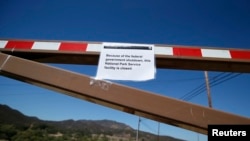WASHINGTON —
The U.S. government shut down Tuesday after the two houses of Congress failed to agree on a spending bill to keep the government running beyond October 1.
During a government shutdown, federal workers not considered "essential" are temporarily laid off, or furloughed, and many government programs are halted. "Essential" employees are defined as those performing duties vital to national defense, public health and safety, or other critical operations.
Past shutdowns
This is not the first time lawmakers' lack of agreement has forced the government into bare-minimum operating conditions.
This is the 12th shutdown since 1981. The last and longest shutdown occurred from December 1995 into January 1996 under the Bill Clinton administration and spanned 21 days. It came just a month after a six-day shutdown in November 1995.
Before the 1980s, if Congress could not pass a budget, federal employees continued operating as usual, even while waiting for a spending bill to pass. Once it did, that bill would retroactively fund the spending gap.
But in 1980, Jimmy Carter's last year as president, then-attorney general Benjamin Civiletti issued a legal opinion saying government work cannot continue until Congress agrees to fund it. Civiletti later clarified the law to mean only "essential" government services could continue without a spending bill.
During Ronald Reagan's presidency from 1981 to 1989, shutdowns were relatively common, but none of them lasted more than three days, and many occurred over a weekend.
Shutdown costs
The longer a shutdown lasts, the more it costs.
The Office of Management and Budget estimated the cost of the two government shutdowns of 1995 to 1996 at more than $1.4 billion. The Pew Research Center says that would be equal to $2.1 billion now, when adjusted for inflation.
And what about the costs to Americans' confidence in their government? If history is any indication, research organization Gallup says that may not pose much of a problem for President Barack Obama or Republican House Speaker John Boehner.
Gallup says the 1995-1996 shutdown "did little to impact" Americans' views of President Clinton or Speaker of the House Newt Gingrich in the months after the closure began. Approval ratings for Congress as a whole, the U.S. economy and the country in general also were spared.
During a government shutdown, federal workers not considered "essential" are temporarily laid off, or furloughed, and many government programs are halted. "Essential" employees are defined as those performing duties vital to national defense, public health and safety, or other critical operations.
Past shutdowns
This is not the first time lawmakers' lack of agreement has forced the government into bare-minimum operating conditions.
This is the 12th shutdown since 1981. The last and longest shutdown occurred from December 1995 into January 1996 under the Bill Clinton administration and spanned 21 days. It came just a month after a six-day shutdown in November 1995.
Before the 1980s, if Congress could not pass a budget, federal employees continued operating as usual, even while waiting for a spending bill to pass. Once it did, that bill would retroactively fund the spending gap.
But in 1980, Jimmy Carter's last year as president, then-attorney general Benjamin Civiletti issued a legal opinion saying government work cannot continue until Congress agrees to fund it. Civiletti later clarified the law to mean only "essential" government services could continue without a spending bill.
During Ronald Reagan's presidency from 1981 to 1989, shutdowns were relatively common, but none of them lasted more than three days, and many occurred over a weekend.
Shutdown costs
The longer a shutdown lasts, the more it costs.
The Office of Management and Budget estimated the cost of the two government shutdowns of 1995 to 1996 at more than $1.4 billion. The Pew Research Center says that would be equal to $2.1 billion now, when adjusted for inflation.
And what about the costs to Americans' confidence in their government? If history is any indication, research organization Gallup says that may not pose much of a problem for President Barack Obama or Republican House Speaker John Boehner.
Gallup says the 1995-1996 shutdown "did little to impact" Americans' views of President Clinton or Speaker of the House Newt Gingrich in the months after the closure began. Approval ratings for Congress as a whole, the U.S. economy and the country in general also were spared.












